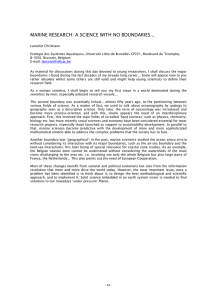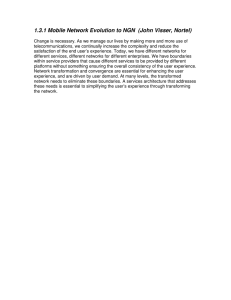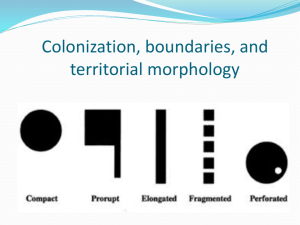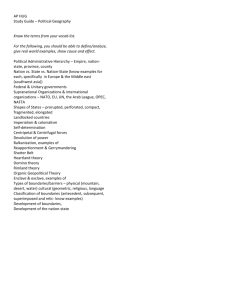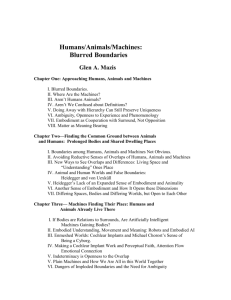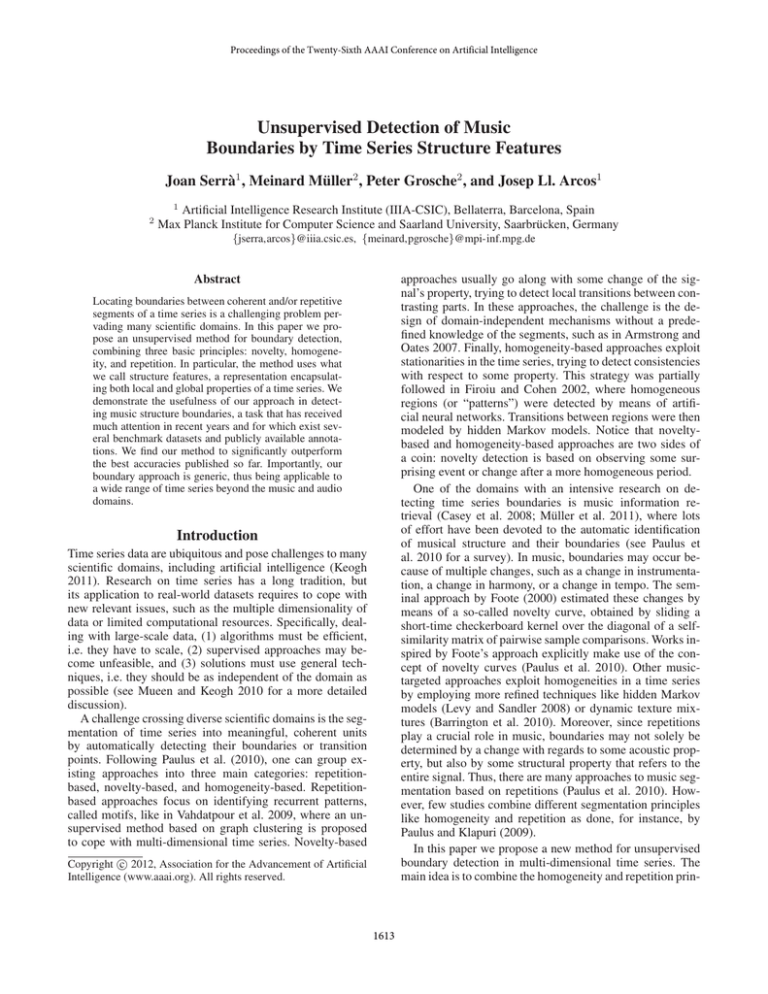
Proceedings of the Twenty-Sixth AAAI Conference on Artificial Intelligence
Unsupervised Detection of Music
Boundaries by Time Series Structure Features
Joan Serrà1 , Meinard Müller2 , Peter Grosche2 , and Josep Ll. Arcos1
1
2
Artificial Intelligence Research Institute (IIIA-CSIC), Bellaterra, Barcelona, Spain
Max Planck Institute for Computer Science and Saarland University, Saarbrücken, Germany
{jserra,arcos}@iiia.csic.es, {meinard,pgrosche}@mpi-inf.mpg.de
Abstract
approaches usually go along with some change of the signal’s property, trying to detect local transitions between contrasting parts. In these approaches, the challenge is the design of domain-independent mechanisms without a predefined knowledge of the segments, such as in Armstrong and
Oates 2007. Finally, homogeneity-based approaches exploit
stationarities in the time series, trying to detect consistencies
with respect to some property. This strategy was partially
followed in Firoiu and Cohen 2002, where homogeneous
regions (or “patterns”) were detected by means of artificial neural networks. Transitions between regions were then
modeled by hidden Markov models. Notice that noveltybased and homogeneity-based approaches are two sides of
a coin: novelty detection is based on observing some surprising event or change after a more homogeneous period.
One of the domains with an intensive research on detecting time series boundaries is music information retrieval (Casey et al. 2008; Müller et al. 2011), where lots
of effort have been devoted to the automatic identification
of musical structure and their boundaries (see Paulus et
al. 2010 for a survey). In music, boundaries may occur because of multiple changes, such as a change in instrumentation, a change in harmony, or a change in tempo. The seminal approach by Foote (2000) estimated these changes by
means of a so-called novelty curve, obtained by sliding a
short-time checkerboard kernel over the diagonal of a selfsimilarity matrix of pairwise sample comparisons. Works inspired by Foote’s approach explicitly make use of the concept of novelty curves (Paulus et al. 2010). Other musictargeted approaches exploit homogeneities in a time series
by employing more refined techniques like hidden Markov
models (Levy and Sandler 2008) or dynamic texture mixtures (Barrington et al. 2010). Moreover, since repetitions
play a crucial role in music, boundaries may not solely be
determined by a change with regards to some acoustic property, but also by some structural property that refers to the
entire signal. Thus, there are many approaches to music segmentation based on repetitions (Paulus et al. 2010). However, few studies combine different segmentation principles
like homogeneity and repetition as done, for instance, by
Paulus and Klapuri (2009).
In this paper we propose a new method for unsupervised
boundary detection in multi-dimensional time series. The
main idea is to combine the homogeneity and repetition prin-
Locating boundaries between coherent and/or repetitive
segments of a time series is a challenging problem pervading many scientific domains. In this paper we propose an unsupervised method for boundary detection,
combining three basic principles: novelty, homogeneity, and repetition. In particular, the method uses what
we call structure features, a representation encapsulating both local and global properties of a time series. We
demonstrate the usefulness of our approach in detecting music structure boundaries, a task that has received
much attention in recent years and for which exist several benchmark datasets and publicly available annotations. We find our method to significantly outperform
the best accuracies published so far. Importantly, our
boundary approach is generic, thus being applicable to
a wide range of time series beyond the music and audio
domains.
Introduction
Time series data are ubiquitous and pose challenges to many
scientific domains, including artificial intelligence (Keogh
2011). Research on time series has a long tradition, but
its application to real-world datasets requires to cope with
new relevant issues, such as the multiple dimensionality of
data or limited computational resources. Specifically, dealing with large-scale data, (1) algorithms must be efficient,
i.e. they have to scale, (2) supervised approaches may become unfeasible, and (3) solutions must use general techniques, i.e. they should be as independent of the domain as
possible (see Mueen and Keogh 2010 for a more detailed
discussion).
A challenge crossing diverse scientific domains is the segmentation of time series into meaningful, coherent units
by automatically detecting their boundaries or transition
points. Following Paulus et al. (2010), one can group existing approaches into three main categories: repetitionbased, novelty-based, and homogeneity-based. Repetitionbased approaches focus on identifying recurrent patterns,
called motifs, like in Vahdatpour et al. 2009, where an unsupervised method based on graph clustering is proposed
to cope with multi-dimensional time series. Novelty-based
c 2012, Association for the Advancement of Artificial
Copyright Intelligence (www.aaai.org). All rights reserved.
1613
a multi-dimensional time series X̂ = [x̂1 , . . . x̂N ] of length
N = N 0 − w.
ciples in a single representation we refer to as structure feature. Structure features are computed for every time series
sample, but encode the structural relation of this sample to
all other samples in the time series. Since we deal with a local phenomenon (a boundary) which may depend on some
global phenomenon (the repetitive structure of the time series), a novelty curve is then computed from the sequence
of structure features. Thus, we obtain a novelty curve that
reflects both local changes and global characteristics1 , specially including beginnings and endings of repeated and/or
homogeneous segments. Notably, our approach and the construction of structure features is independent of the type of
time series used and, therefore, it is not restricted to musicderived signals.
The remainder of the paper is organized as follows. First,
we describe our method. Second, we summarize the evaluation methodology followed. Third, we report on the results
obtained. Fourth, a brief conclusion closes the paper.
Homogeneities and recurrences
The next step consists in assessing homogeneities and recurrences. For that we resort to a recurrence plot (Marwan
et al. 2007), which consists of a square matrix R whose elements Ri,j indicate pairwise resemblance between samples
at times i and j (Fig. 1, third row). Formally, for i, j =
1, . . . N ,
Ri,j = Θ (εi,j − kx̂i − x̂j k) ,
(2)
where Θ(z) is the Heaviside step function, yielding 1 if
z > 0 and 0 otherwise, k k can be any norm (we use the
Euclidean norm), and ε is a suitable threshold.
As done by Serrà et al. (2009), we set a different threshold
εi,j for each cell (i, j). Specifically, our procedure for building R can be outlined as follows. First, for each sample x̂i ,
i = 1, . . . N , we search for its K nearest neighbors. Then,
neighbor mutuality is forced by setting Ri,j = 1 only if x̂i
is a neighbor of x̂j and, at the same time, x̂j is a neighbor
of x̂i . In our experience with recurrence plots we found this
restrictive strategy to be more robust against noise than the
variants outlined by Marwan et al. (2007). To account for
time series of different lengths, we set K = κN , i.e. we set
the number of nearest neighbors to a fraction κ ∈ [0, 1] of
the length of the time series being considered.
Method
Our method consists of four main steps: (1) Emulate the capacity of short-time human memory by encapsulating, in a
new sample, the most recent past of a time series sample.
(2) Assess homogeneities and repetitions found in a time series by pairwise comparison of the previously encapsulated
samples. (3) Construct the structure features of a time series. Structure features are obtained by considering temporal lag information and by estimating a bivariate probability density with Gaussian kernels. (4) Compute differences
between consecutive structure features to simulate boundary
perception. This final step yields a novelty curve whose peak
positions indicate boundary estimates. We now detail these
four steps.
Structure features
The subsequent steps involve the creation of structure features (SF). We first represent the homogeneities and recurrences of R in a circular time-lag matrix L (Fig. 1, third row,
left). Such process is similar to the typical process of constructing a time-lag matrix (Goto 2006) but incorporates the
information of future, as well as past time lags. We do it by
circularly shifting the rows of R such that
Accounting for the recent past
Let there be a time series X = [x1 , . . . xN 0 ], of length N 0 ,
with potentially multi-dimensional samples xi (column vectors). To emulate short-time memory (Baddeley 2003), information of the most recent past is incorporated to every
sample xi . This can be easy and elegantly done by using delay coordinates, a technique routinely employed in nonlinear
time series analysis (Kantz and Schreiber 2004). New samples are constructed by vector concatenation as
h
iT
T
T
x̂i = xT
,
(1)
i xi−τ · · · xi−(m−1)τ
Li,j = Ri,k+1
for i, j = 1, . . . N , where k equals to i + j − 2 modulo N .
The circular time matrix L can then be considered as a
sample from a bivariate distribution P̄ along the time and
lag axes (i and j axes, respectively). This bivariate distribution would correspond to a probability mass function of
time-lag recurrences2 . The estimate P such an underlying
distribution P̄ is obtained using bivariate kernel density estimation (Simonoff 1996), a fundamental data smoothing concept where inferences about a population are made based on
a finite sample of it. In our case, P is estimated by convolving L with a bivariate rectangular Gaussian kernel G:
where T denotes vector transposition, m is the so-called embedding dimension, and τ is a time delay. Although there are
recipes to estimate the optimal values of m and τ from the
information contained in a time series X, we leave them as
parameters (see below). Note that the value of m indicates
the amount of past information being considered for the task
which, in general, ranges a time span of w = (m − 1)τ . In
preliminary analysis we found that considering past information (m > 1) provided more stability to the method and
substantial increases in accuracy (see also the results section). By applying Eq. 1 for i = w + 1, . . . N 0 we obtain
1
(3)
P = L ∗ G.
(4)
The kernel G is obtained by multiplying two Gaussian windows gt and gl of variance σ 2 , with sizes st and sl , corresponding to the time and lag dimensions of L, respectively.
This way, G has st rows and sl columns:
G = gt gl T .
2
(5)
Actually, it is not needed that the values of P̄ sum to 1, since
such normalization only introduces a scale parameter that is eliminated in a subsequent operation (see below).
This point largely differs from Foote’s approach.
1614
B EATLES -A
B EATLES -B
RWC-P OP -A
RWC-P OP -B
Num.
174
180
100
100
Length
158.2 (51.5)
162.9 (56.6)
242.2 (41.5)
224.1 (41.4)
N. Bound.
8.2 (2.3)
9.2 (2.3)
16.1 (4.0)
16.8 (3.4)
Interval
17.2 (12.3)
16.0 (13.9)
14.1 (6.8)
13.7 (7.2)
Table 1: Datasets’ statistics (standard deviations into parenthesis): number of recordings, average length, average number of boundaries, and average length of inter-boundary interval (the time between two consecutive boundaries). Time
values are given in secs.
features pi are then defined to be the rows of P , i.e. P =
T
[p1 , . . . pN ] . Because of the nature of the recurrence plot,
they encapsulate both homogeneities and repetitions. Furthermore, by employing a Gaussian kernel, they gain robustness against time and lag deviations and transitions between
them become smooth (see below).
Novelty curve
Our observation is that structural boundaries of the time series X̂ correspond to relative changes in the sequence of
structure features P . To measure these changes we compute
the difference between successive structure features pi . This
yields a unidimensional novelty curve c = [c1 , . . . cN −1 ],
where ci = kpi+1 − pi k2 (we again use the Euclidean norm,
but now take the square of it). The novelty curve c can be
linearly normalized between 0 and 1 by subtracting its minimum value and subsequently dividing it by the resultant
maximum (Fig. 1, bottom).
Positions of prominent peaks of c are finally selected as
segment boundaries. Here, we opt for a rather simple peak
selection strategy: a sample ci is considered to be a peak
if it is above a certain threshold δ and, at the same time,
corresponds to the global maximum of a window of length λ
centered at ci . Finally, the locations of the boundaries of the
original time series X are set to the locations of the selected
peaks plus w/2 to compensate for the offset introduced by
delay coordinates in Eq. 1.
Experimental setup
Datasets
To evaluate our method in the context of music boundary detection we use two benchmark music datasets with boundary and structure annotations: Beatles and RWC-Pop. The
Beatles dataset corresponds to all the recordings in the 12
original albums of the band. There are two versions for
ground truth annotations of this dataset, which are denoted
as B EATLES -A3 and B EATLES -B4 (Table 1). Since many
works in the literature have used B EATLES -A for evaluation,
it is easy to compare the results obtained here with theirs.
The second dataset consists of all recordings of the Real
World Computing Popular Music Database (Goto et al.
2002). These recordings represent Japanese mainstream music and, to a less extent, American chart hits. We also
Figure 1: Illustration of the method using an artificially generated time series. From top to bottom, sub-figures show X,
X̂, R, L and P , and c. Notice how R, and therefore also L
and P , reflect the homogeneity region between 400 and 600
and the repetitions starting near 200 and 600. These boundaries are clearly reflected as prominent peaks in c.
3
The estimated kernel density P can be seen as a time series along the time axis (Fig. 1, third row, right). Structure
4
1615
http://www.cs.tut.fi/sgn/arg/paulus/beatles sections TUT.zip
http://isophonics.net/content/reference-annotations
use a variance σ 2 = 0.16, what ensures a value close to 0 at
the borders of g (Simonoff 1996). Finally, to take the peaks
of c, we set δ = 0.05 (5% of the maximum amplitude of c;
values of δ ∈ [0, 0.25] did not affect the results in a substantial way) and λ = 12 sec (note that we force boundaries to
be separated at least 6 sec; therefore we prevent the trivial
case of Baseline 3 mentioned in the next subsection).
The previous setting leaves us with just three important
parameters: m (the amount of recent past we consider for
xi ; Eq. 1), κ (which controls the amount of a sample’s nearest neighbors in R; Eq. 2), and st (the length of the time
dimension of the kernel G; Eq. 5). Thus, our method based
on structure features is mostly parameterized by SF(m,κ,st ).
We here do not perform an exhaustive search for the best parameters, but report results only for some representative parameter combinations. As it turns out, the results are already
very good without any optimization and rather independent
of the specific parameter settings.
The parameter values we try for m, κ, and st can be also
justified by the nature of the data and the characteristics of
the task. Suitable values for m may be comprised between 0
and 5 secs, according to the literature on short-term memory
(cf. Baddeley 2003). Suitable values for κ may be roughly
below 0.05 (i.e. below 5% of the length of our time series). If
we suppose we have 10 repetitions in a time series of length
1000, this implies κ = 0.01 (or higher if we consider some
noisy matches in R). Finally, suitable values for st may be
found around 30 secs. If the length of our Gaussian kernel
is 30 secs, then the Gaussian shape is maximal at 15 secs
and decreases by 50% at 8 and 23 secs (Simonoff 1996).
This yields an ‘effective’ kernel length of approximately 15
secs, close to the average time between boundaries shown in
Table 1.
use two versions of annotations as ground truth, which are
denoted by RWC-P OP -A5 and RWC-P OP -B6 (Table 1).
RWC-P OP -B has been used as part of the Music Information Retrieval Evaluation eXchange (MIREX), an international evaluation campaign for certain music processing
tasks (Downie 2008). The RWC recordings and the two annotations are publicly available.
Music descriptor time series
The time series we use are sequences of harmonic pitch
class profiles (HPCPs; Gómez 2004). Pitch class profiles
(PCP; also called chroma) are widely used in the music information retrieval community (Casey et al. 2008;
Müller et al. 2011) and have proven to work well as primary
source of information for many music processing tasks, including boundary and structure retrieval (Paulus et al. 2010).
PCP descriptors represent the harmonic (or tonal) properties
of a music signal, and are specially suitable for highlighting
structure repetitions.
PCP descriptors are derived from the frequency dependent energy in a given range in short-time spectral representations of audio signals computed in a moving window. This
energy is usually mapped into an octave-independent histogram representing the relative intensity of each of the 12
semitones of the western chromatic scale (12 pitch classes:
C, C#, D, D#, etc.). To normalize with respect to loudness,
this histogram can be divided by its maximum value, thus
leading to values between 0 and 1. In general, PCPs are
robust against non-tonal components (e.g. ambient noise or
percussive sounds) and independent of timbre and the specific instruments used.
HPCPs are an enhanced version of PCPs: they reduce the
influence of noisy spectral components, are tuning independent, and take into account the presence of harmonic frequencies (Gómez 2004). The computation of HPCPs in a
moving window results in a 12-dimensional time series X
for each music recording (Fig. 2, top). We use the same implementation and parameters employed by Serrà et al. 2008,
with 12 pitch classes, a window length of 0.186 sec, and a
hop size of 0.14 sec7 .
Evaluation measures
We use the same evaluation measures as used in the literature of music boundary detection: hit rates and median deviations (cf. Smith 2010). For hit rates, segment boundaries
are accepted to be correct if they are within a certain threshold from a boundary in the ground truth annotation. Common thresholds are 0.5 and 3 sec (Ong and Herrera 2005;
Turnbull et al. 2007). Based on the matched hits, standard
precision, recall, and F-measure can be computed for each
music recording and averaged across the whole dataset.
Since we observed that some annotations were not accurate
at a resolution of 0.5 sec, we only report precision, recall,
and F-measure using a 3 sec threshold.
Additionally, two median deviation values can be computed, counting the median times (given in secs) from trueto-guess and from guess-to-true (Turnbull et al. 2007). The
median true-to-guess (MT2G) is the median time from
boundaries in the ground truth to the closest boundaries in
the result. The median guess-to-true (MG2T) is, similarly,
the median time from boundaries in the result to boundaries
in the ground truth. Median values are also computed for
each music recording and averaged across the whole dataset.
One should be cautious with the aforementioned evaluation measures, since they may not be the most suitable for
the task. For instance, placing a boundary every second can
Method parameters
From the explanation of the method it may seem that quite a
number of parameters need to be adjusted. However, by considering the nature of the time series and the characteristics
of the task, many of them can be pre-specified. For instance,
since the time series we will consider fluctuate rapidly, we
set τ = 1 so that no information from the recent past of xi is
lost in building x̂i (Eq. 1). Similarly, since no dramatic speed
or tempo change may occur in our time series, there will be
few fluctuations along the lag dimension of L, and therefore
a value of sl = 0.3 sec for the kernel G will suffice to track
them (Eq. 5). For the Gaussian windows gt and gl we can
5
http://staff.aist.go.jp/m.goto/RWC-MDB/AIST-Annotation
http://musicdata.gforge.inria.fr
7
We express all time-related values in seconds; they can be
easily converted to samples by multiplying by the sampling rate
0.14−1 = 7.14 Hz.
6
1616
already yield a Recall of 1 and an F-measure close to 0.5
(Smith 2010). The two median times may also hide bad results for some fraction of the boundaries. However, for the
sake of comparison with existing approaches, we also revert
to these measures. Additionally, we provide three baselines
for the evaluation measures above: placing a boundary at every average boundary length (Baseline 1), placing a certain
number of boundaries randomly (Baseline 2), and placing a
boundary every 3 secs (Baseline 3).
In addition, one should note that two different human annotators could disagree in the placement of a music structure
boundary, or even whether a given musical event or sequence
should be considered as such (see Peeters and Deruty 2009
or, for instance, the summaries for the two versions of the
annotations we show in Table 1). To obtain a reference of human performance when evaluating against our ground truth
we propose to cross-evaluate annotations. That is, given two
annotations for the same music dataset, we use annotation B
as a result when evaluating with the ground truth provided
by annotation A and vice versa (e.g. using B EATLES -B for
evaluating B EATLES -A). This way we can have a rough upper estimate of how a human would perform in the boundary
detection task.
Results
Before presenting the quantitative results, we first give an
illustrating example based on a real-world HPCP time series computed from “All you need is love” by The Beatles
(Fig. 2). We see that homogeneities (gray areas) and repetitions (straight diagonal lines) are already visible in the recurrence matrix R. In this case, the majority of the detected
boundaries correspond to real boundaries (Fig. 2, bottom).
Interestingly, there is an undetected boundary at sample 683,
which would have been detected if we had not set a too strict
λ for preventing the trivial case of Baseline 3 (see above).
This boundary corresponds to a change from a guitar solo to
a ‘bridge’ part, both before the voice enters again. The two
false positive boundaries towards the end (samples 1408 and
1518) correspond to a short musical quotation of the main
chorus of the song “She loves you”, which The Beatles included in the final fade-out of this recording. These (actually
musically meaningful) boundaries had not been annotated
by humans, which again highlights the problems of collecting ground truth annotations for this task.
Let us turn to quantitative results (Tables 2 and 3). First,
we observe that, independently of the dataset and ground
truth we use, different parameter combinations for the structure feature (SF) approach yield similar results, no matter
which evaluation measure we consider. Actually, many of
these results turned out to be not statistically significantly
different8 between them. This highlights the robustness of
the approach against different parameter settings.
Second, we can see that SF reaches accuracies that are
Figure 2: Example with “All you need is love” from The
Beatles. From top to bottom the plots show X, R, L and
P , and c (we omit X̂ due to space constraints). The novelty
curve c also shows the found boundaries (red dash-dotted
lines) and the ground truth boundaries (black solid lines).
very far above the baselines (Table 2). The highest Fmeasure obtained was 0.576 (0.094) with Baseline 3 and
RWC-P OP -A, whereas the lowest F-measure obtained by
the SF approach is 0.724 (0.152) with B EATLES -A. Human
performance is still higher than our approach’s, but the difference gets tighter. For instance, with RWC-P OP -B we get
an F-measure of 0.800 (0.107) and human performance is at
0.899 (0.086). MT2G and MG2T are quite different though.
Third, the accuracies achieved by SF are statistically
8
Statistical significance was assessed with a T-test (p < 0.01),
assuming a Gaussian distribution of the evaluation measures. When
standard deviations were not reported in the literature, equal variances were assumed for the test. In the rest of our manuscript, standard deviations are always reported into parenthesis.
1617
Method
Baseline 1 (every 17 sec)
Baseline 2 (8 rand. bound.)
Baseline 3 (every 3 sec)
Human
Baseline 1 (every 16 sec)
Baseline 2 (9 rand. bound.)
Baseline 3 (every 3 sec)
Human
Baseline 1 (every 14 sec)
Baseline 2 (16 rand. bound.)
Baseline 3 (every 3 sec)
Human
Baseline 1 (every 14 sec)
Baseline 2 (17 rand. bound.)
Baseline 3 (every 3 sec)
Human
F-meas Precision
B EATLES -A
0.403
0.387
0.410
0.401
0.505
0.347
0.911
0.889
B EATLES -B
0.404
0.388
0.465
0.440
0.516
0.355
0.911
0.937
RWC-P OP -A
0.423
0.421
0.449
0.478
0.576
0.411
0.899
0.921
RWC-P OP -B
0.424
0.401
0.453
0.442
0.569
0.402
0.899
0.891
Recall
MT2G
MG2T
0.438
0.441
0.998
0.937
4.74
4.42
4.94
0.28
3.77
4.20
0.64
0.27
0.443
0.519
1.000
0.889
4.97
4.47
5.15
0.27
3.73
3.13
0.69
0.28
0.437
0.438
1.000
0.891
3.85
3.41
3.88
0.23
3.52
4.00
0.68
0.33
0.462
0.478
1.000
0.921
4.08
3.80
4.05
0.33
3.31
3.37
0.67
0.23
Method
Levy & Sandler (2008)a
Peiszer (2007)b
SF(4,0.04,30)
SF(3.5,0.03,30)
SF(3,0.03,25)
SF(2.5,0.02,25)
SF(4,0.04,30)
SF(3.5,0.03,30)
SF(3,0.03,25)
SF(2.5,0.02,25)
Levy & Sandler (2008)b
Peiszer (2007)b
SF(4,0.04,30)
SF(3.5,0.03,30)
SF(3,0.03,25)
SF(2.5,0.02,25)
Peeters (2010)c
Mauch et al. (2009)c
Sargent et al. (2011)
SF(4,0.04,30)
SF(3.5,0.03,30)
SF(3,0.03,25)
SF(2.5,0.02,25)
Table 2: Baselines and estimated human accuracies (best
baseline F-measures are highlighted in bold). Baselines 1
and 2 use the information specified in Table 1.
significantly higher than the ones reported in the literature so far (Table 3). For instance, the best F-measures
we could find for B EATLES -A were all below 0.62, as reported by Smith (2010). Contrastingly, our approach reaches
0.752 (0.152). With RWC-P OP -A, the same author reported
higher F-measures, but all below 0.68. With the same ground
truth we reach 0.791 (0.122). With RWC-P OP -B, Sargent et
al. (2011) obtained an F-measure of 0.627, whereas we reach
0.800 (0.107). MT2G and MG2T measures also corroborate
a significant difference in accuracy between the SF approach
and the numbers available in the literature.
Apart from the literature results shown in Table 3, one
should mention the F-measure of 0.75 obtained by Ong
and Herrera (2005) on a 54-song subset of B EATLES -A.
Their method was quite elaborate, involving two phases and
nine steps, combining the information from different music descriptor time series, and applying a post-processing
step to refine the results. Using the same song subset with
SF(4,0.04,30) we obtain an F-measure of 0.77 (0.134),
which is higher than theirs but not statistically significantly
different. Therefore, we obtain a comparable accuracy with
a much simpler and generic approach. In addition, it should
be noted that we do not perform an exhaustive parameter
optimization which may further improve the results.
We should finally discuss the results obtained by Turnbull et al. (2007), who report relatively high F-measures for
the RWC-Pop recordings using a supervised approach combining decision stumps and boosting. However, it is difficult to compare such results. First, they used an alternative
annotation just considering 4 structural labels. This annotation discards many boundaries, and has been reported to
be slightly unreliable (Smith 2010). Furthermore, they reported hit rates with a threshold of 0.5 instead of 3 sec. As
mentioned, we empirically found some inaccuracies in the
annotations within a resolution of 0.5 sec, which could only
be correctly detected by a supervised approach. Finally, we
should mention that they achieve an MT2G of 1.58 and an
F-meas Precision
B EATLES -A
0.612
0.600
0.616
0.515
0.752
0.726
0.749
0.726
0.735
0.689
0.724
0.679
B EATLES -B
0.769
0.753
0.774
0.760
0.756
0.718
0.750
0.715
RWC-P OP -A
0.661
0.774
0.680
0.613
0.764
0.823
0.771
0.834
0.786
0.813
0.791
0.817
RWC-P OP -B
0.571
0.575
0.605
0.736
0.627
0.634
0.781
0.821
0.790
0.834
0.798
0.808
0.800
0.810
Recall
MT2G
MG2T
0.646
0.824
0.797
0.790
0.806
0.792
1.87
1.89
2.04
2.01
1.17
1.27
1.19
1.22
0.805
0.807
0.819
0.810
2.00
1.91
2.14
2.07
1.13
1.07
1.03
1.08
0.755
0.807
0.729
0.733
0.776
0.783
1.42
1.42
1.35
1.32
1.70
1.67
1.45
1.41
0.591
0.544
0.641
0.757
0.764
0.803
0.805
1.57
2.66
1.27
1.25
1.23
1.27
1.78
1.27
1.35
1.33
1.20
1.18
Table 3: Boundary detection results (best F-measures highlighted in bold). Lines in italics correspond to the best results
reported in the literature so far. The a,b,c superscripts denote
results reported by Paulus and Klapuri (2009), Smith (2010),
and the MIREX campaign (Downie 2008), respectively.
Standard deviations for SF were 0.16 ± 0.02 for precision,
recall, and F-measure, 1.2 ± 0.9 for MT2G, and 0.7 ± 0.2
for MG2T.
MG2T of 4.29, which are worse than the values reported
here for RWC-P OP -A and RWC-P OP -B.
Conclusion
In this paper we have introduced an unsupervised method for
detecting time series boundaries based on structure features,
incorporating three basic principles for boundary detection:
novelty, homogeneity, and repetition. We tested the usefulness of the method in the task of segmenting music recordings based on their structure and found that it performed significantly better than any other existing approach. Since the
proposed method is generic, it can be easily applied to time
series from other scientific domains beyond music information retrieval. In the future we intend to use similar techniques for segmenting motion-capture data into coherent
body movements or for automatically detecting non-trivial
boundaries in stock market data.
Acknowledgments
JS and JLA acknowledge 2009-SGR-1434 from Generalitat de Catalunya, TIN2009-13692-C03-01 from the Spanish Government, and EU Feder Funds. JS also acknowledges JAEDOC069/2010 from Consejo Superior de Investigaciones Cientı́ficas. MM and PG acknowledge the Cluster of Excellence on Multimodal Computing and Interaction
(MMCI).
1618
References
Müller, M.; Ellis, D. P. W.; Klapuri, A.; and Richard, G.
2011. Signal processing for music analysis. IEEE Journal
of Selected Topics in Signal Processing 5(6):1088–1110.
Ong, B. S., and Herrera, P. 2005. Semantic segmentation of
music audio contents. In Proc. of the Int. Computer Music
Conf. (ICMC).
Paulus, J., and Klapuri, A. 2009. Music structure analysis using a probabilistic fitness measure and a greedy search
algorithm. IEEE Trans. on Audio, Speech, and Language
Processing 17(6):1159–1170.
Paulus, J.; Müller, M.; and Klapuri, A. 2010. Audio-based
music structure analysis. In Proc. of the Int. Soc. for Music
Information Retrieval Conf. (ISMIR), 625–636.
Peeters, G., and Deruty, E. 2009. Is music structure annotation multi-dimensional? A proposal for robust local music
annotation. In Proc. of the Workshop on Learning the Semantics of Audio Signals (LSAS), 75–90.
Peeters, G. 2010. MIREX 2010 music structure segmentation task: IRCAMSUMMARY submission. Music Information Retrieval Evaluation eXchange (MIREX).
Peiszer, E. 2007. Automatic audio segmentation: segment
boundary and structure detection in popular music. MSc
thesis, Vienna University of Technology, Vienna, Austria.
Sargent, G.; Bimbot, F.; and Vincent, E. 2011. A regularityconstrained Viterbi algorithm and its application to the structural segmentation of songs. In Proc. of the Int. Soc. for
Music Information Retrieval Conf. (ISMIR), 483–488.
Serrà, J.; Gómez, E.; Herrera, P.; and Serra, X. 2008.
Chroma binary similarity and local alignment applied to
cover song identification. IEEE Trans. on Audio, Speech,
and Language Processing 16(6):1138–1151.
Serrà, J.; Serra, X.; and Andrzejak, R. G. 2009. Cross recurrence quantification for cover song identification. New
Journal of Physics 11(9):093017.
Simonoff, J. S. 1996. Smoothing methods in statistics.
Springer Series in Statistics. Berlin, Germany: Springer.
Smith, J. B. L. 2010. A comparison and evaluation of approaches to the automatic formal analysis of musical audio.
MSc thesis, McGill University, Montreal, Canada.
Turnbull, D.; Lanckriet, G.; Pampalk, E.; and Goto, M.
2007. A supervised approach for detecting boundaries in
music using difference features and boosting. In Proc. of the
Int. Conf. on Music Information Retrieval (ISMIR), 51–54.
Vahdatpour, A.; Amini, N.; and Sarrafzadeh, M. 2009.
Toward unsupervised activity discovery using multidimensional motif detection in time series. In Proc. of
the Int. Joint Conf. on Artificial Intelligence (IJCAI), 1261–
1266.
Armstrong, T., and Oates, T. 2007. UNDERTOW: multilevel segmentation of real-valued time series. In Proc. of the
AAAI Int. Conf. on Artificial Intelligence, 1842–1843.
Baddeley, A. 2003. Working memory: looking back and
looking forward. Nature Reviews Neuroscience 4(10):829–
839.
Barrington, L.; Chan, A. B.; and Lanckriet, G. 2010. Modeling music as a dynamic texture. IEEE Trans. on Audio,
Speech, and Language Processing 18(3):602–612.
Casey, M. A.; Veltkamp, R.; Goto, M.; Leman, M.; Rhodes,
C.; and Slaney, M. 2008. Content-based music information
retrieval: current directions and future challenges. Proceedings of the IEEE 96(4):668–696.
Downie, J. S. 2008. The music information retrieval evaluation exchange (2005-2007): a window into music information retrieval research. Acoustical Science and Technology
29(4):247–255.
Firoiu, L., and Cohen, P. R. 2002. Segmenting time series
with a hybrid neural networks - hidden Markov model. In
Proc. of the AAAI Int. Conf. on Artificial Intelligence, 247–
252.
Foote, J. 2000. Automatic audio segmentation using a measure of audio novelty. In Proc. of the IEEE Int. Conf. on
Multimedia and Expo (ICME), 452–455.
Gómez, E. 2004. Tonal description of polyphonic audio for
music content processing. INFORMS Journal on Computing
18(3):294–304.
Goto, M.; Hashiguichi, H.; Nishimura, T.; and Oka, R. 2002.
RWC music database: popular, classical, and jazz music
databases. In Proc. of the Int. Conf. on Music Information
Retrieval (ISMIR), 287–288.
Goto, M. 2006. A chorus section detection method for musical audio signals and its application to a music listening
station. IEEE Trans. on Audio, Speech and Language Processing 14(5):1783–1794.
Kantz, H., and Schreiber, T. 2004. Nonlinear time series
analysis. Cambridge, UK: Cambridge University Press.
Keogh, E. 2011. Machine learning in time series databases
(and everything is a time series!). Tutorial at the AAAI Int.
Conf. on Artificial Intelligence.
Levy, M., and Sandler, M. 2008. Structural segmentation
of musical audio by constrained clustering. IEEE Trans. on
Audio, Speech and Language Processing 16(2):318–326.
Marwan, N.; Romano, M. C.; Thiel, M.; and Kurths, J.
2007. Recurrence plots for the analysis of complex systems.
Physics Reports 438(5-6):237–329.
Mauch, M.; Noland, K. C.; and Dixon, S. 2009. Using musical structure to enhance automatic chord transcription. In
Proc. of the Int. Soc. for Music Information Retrieval Conf.
(ISMIR), 231–236.
Mueen, A., and Keogh, E. 2010. Online discovery and
maintenance of time series motifs. In Proc. of the Conf. on
Knowledge Discovery and Data Mining (KDD), 1089–1098.
1619

